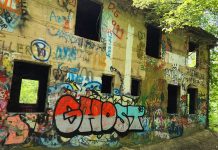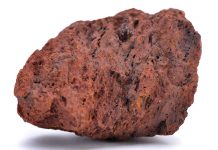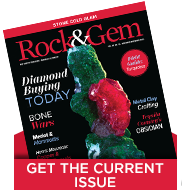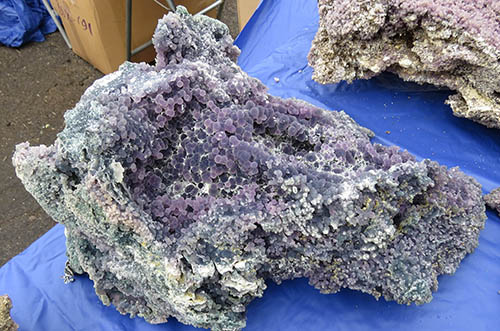
Manakarra grape agate is one of Indonesia’s most striking mineral discoveries, known for its vivid purple, lilac, gray, and pastel-green botryoidal formations that resemble clusters of grapes. First appearing on the global market in the mid-2010s, this material quickly gained attention for both its unusual structure and its remote, challenging locality in West Sulawesi
Early Sightings and Introduction at Gem Shows
In early 2017, dealers began bringing Manakarra grape agate to major gem shows, where the material appeared in larger quantities for the first time. At the Tucson shows, one of the most notable displays came from mineral dealer Lawrence Crouzen, who offered a wide range of specimens at the Rapa River venue.
Across several outdoor tables, visitors could see that the material was available in more colors than initially reported. Along with the distinctive purple shades, clusters appeared in off-white, gray, lilac, deep purple, and pastel green. Many spheres displayed a velvety luster produced by a microscopic druzy quartz coating. Specimens were sold individually, by the gram, and by the kilogram.

Tracing the Origin to West Sulawesi
According to information shared by Crouzen and his U.S. partner, Bill Boss, Manakarra grape agate was first recognized as float material found along Manakarra Beach, a shoreline midway along the west coast of Sulawesi. Pieces had washed down from the steep, jungle-covered mountains inland, carried by streams that emptied into the coastal plain.
Prospectors followed these waterways back into the interior, eventually tracing them to their sources in the headwaters. The active collecting zone now spans an estimated 25 square kilometers, though only a portion has been explored.

A Volcanic Setting for Manakarra Grape Agate
The discovery sits within Indonesia’s extensive volcanic arc, where the Indo-Australian oceanic plate subducts beneath continental crust. The region is known for its complex geology and variety of volcanic rocks.
The host rock for Manakarra grape agate is Miocene-age andesite pillow lava, formed when viscous molten andesite flowed into cold seawater. As the lava chilled rapidly, it formed rounded “pillows” with natural cavities and voids between them. These empty spaces later became the sites where botryoidal chalcedony grew.
The agate often forms in thin sheets or walls projecting into the voids, sometimes resembling honeycomb structures. Many surfaces show the fine druzy coating that enhances color and gives the material its characteristic velvety sheen.
Over time, tectonic activity uplifted these submarine lava flows into the mountainous terrain where mining takes place today.
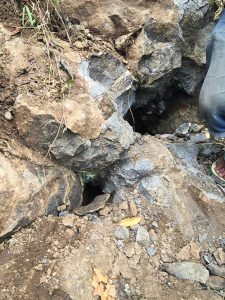
Challenging Conditions at the Mining Sites
Mining Manakarra grape agate remains entirely manual, and the terrain makes mechanized work nearly impossible. There are:
- No access roads
- Long, steep approaches
- Riverbeds used as primary routes
- Flash-flood risks during heavy rains
Miners must carry tools, food, and supplies on foot for several hours, often hiking uphill alongside waterways that can swell rapidly in the tropical climate.
At the site, removing thick vegetation is the first step. Soil is cleared to expose the weathered andesite beneath. Long steel rods are used to probe the ground for hollow spaces, and once voids are identified, miners use hand tools to chip into the pillow structures.
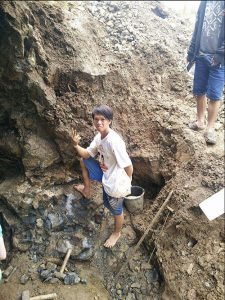
The host rock is extremely tough, and the botryoidal formations are fragile. During extraction, clusters frequently break apart, especially in weathered zones near the surface where color is typically lighter.
Quality improves with depth. Unweathered pillow structures yield the best
- Deep purples
- Lilac tones
- Pastel greens
- Translucent, tight spheres
Once exposed, specimens are gently cleaned and packed for transport. Some are carried out in backpacks; larger clusters are suspended in slings and carried by two people along the narrow river routes.
Camp structures in the mining area are simple, consisting of raised platforms with thatched roofs or plastic tarps. Since there is no formal claim system, miners cover pits when leaving or abandoning them if unproductive.
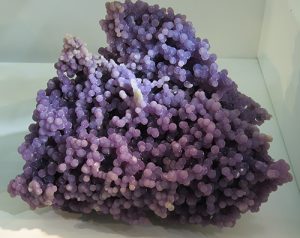
Manakarra Grape Agate: Specimen Quality and Range of Color
Manakarra grape agate displays several natural color varieties, each tied to local mineral chemistry:
- Deep purple – most sought after
- Lilac and lavender – very common
- Gray or off-white – often near surface zones
- Pastel green – rare and highly collected
Specimens may form:
- Individual spheres
- Plate-like sheets of tightly packed orbs
- Large clusters shaped by the contours of pillow cavities
- Sculptural masses that resemble natural forms
Unusual shapes are especially prized and often purchased quickly by international buyers.
Market Trends and Collector Interest
After mining, material is transported to coastal towns, where it is sold directly to buyers or through brokers. Prices vary widely by color, luster, and cluster definition. Large sculptural pieces often enter the Chinese collector market early, sometimes purchased in bulk without in-person inspection.
While the fragile nature of the orbs limits extensive lapidary use, some artists create striking freeform cabochons or drill individual spheres for beadwork. However, the majority of Manakarra grape agate is collected as natural mineral specimens.
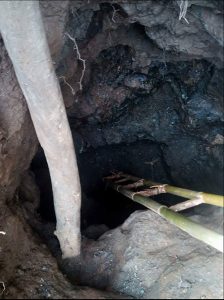
Manakarra Grape Agate: Future Availability
No formal geological survey has mapped the full extent of the pillow-lava formation, either horizontally or in depth. Because the host rock is extremely hard and extraction is done entirely by hand, experts believe the deposit is unlikely to be exhausted quickly. Much of the deeper material may still be untouched.
A Landmark Indonesian Agate Discovery
With its vivid colors, distinctive botryoidal forms, and remote volcanic origin, Manakarra grape agate stands as one of Indonesia’s most remarkable mineral discoveries. The combination of beauty, rarity, and challenging extraction continues to attract collectors worldwide, ensuring its place as a signature mineral from West Sulawesi.
This story about Manakarra grapeagate was written for Rock & Gem magazine. Click here to subscribe. Story and photos from Jim Landon.










